Our History
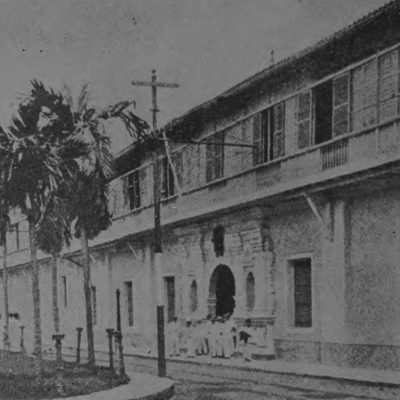
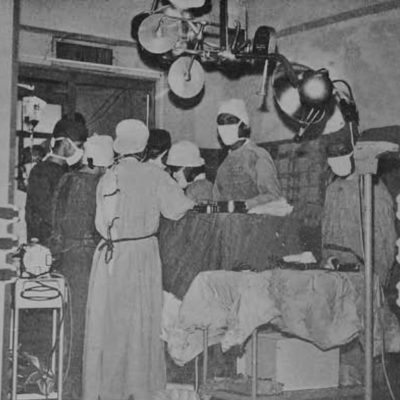
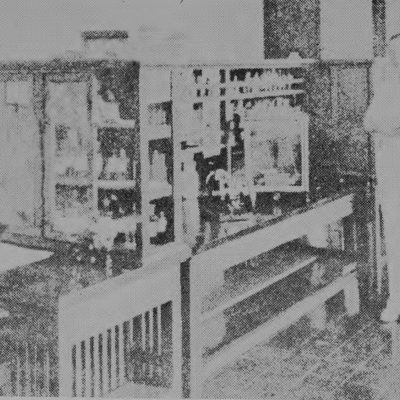
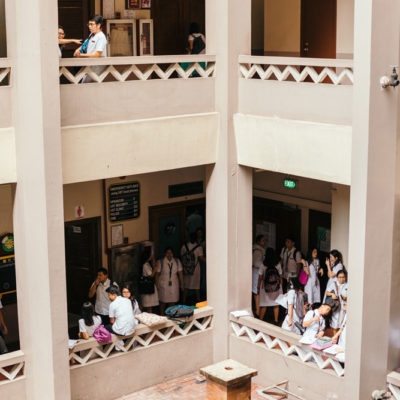
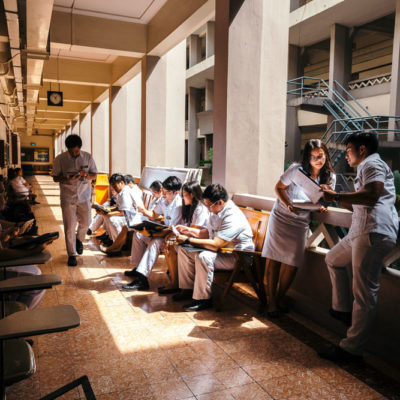
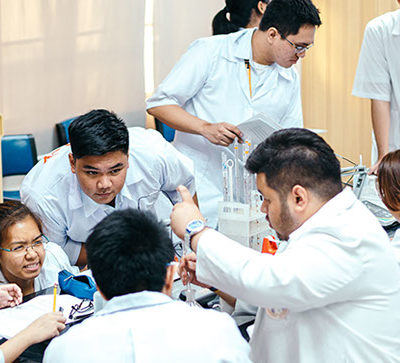
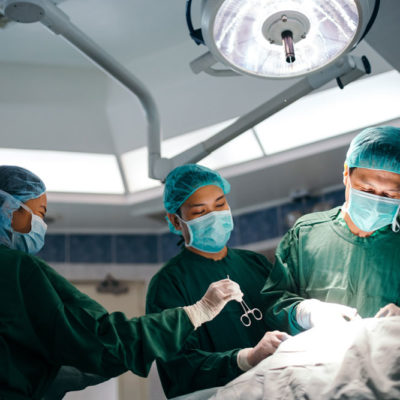
The UST Faculty of Medicine and Surgery (FMS) is the oldest medical school in the Philippines. The “Facultad de Medicina y Farmacia” – the beginnings of the FMS, was formally opened on May 28, 1871, by decree of the “Superior Gobierno de Filipinas.” At that time, there were only 12 practicing doctors in the Philippines, all trained in Europe. The first group of enrollees was 9 (3 Spaniards, 6 Filipinos), and all graduated on March 10, 1877.
The medical curriculum was patterned after leading European medical schools (6 years: one preparatory, five proper), and the language of instruction was Spanish.
Enrollment gradually increased with classes continuing during the Revolutionary period.
The Faculty was ordered closed by the American Military Government in 1898 but was authorized to reopen by Gen. Arthur McArthur in January 1901, during which time it was separated from Pharmacy and henceforth came to be known as the Faculty of Medicine and Surgery.
The medical education system became Americanized, and English became the medium of instruction. In 1932, the first women were admitted to the Faculty by order of the Congregation of Studies of the Holy See.
For the clinical training of its students, the Faculty used the facilities of the Hospital of San Juan de Dios (1875–1941, 1944–45) and St. Paul’s Hospital (1941–44).
Surviving the ravages of World War II, the medical school reopened at the new España Building in 1946 and later transferred to its present building in 1952.
The UST Hospital was established in 1946 and continues to serve as the training hospital of the Faculty of Medicine and Surgery.
Throughout the Spanish, American, and Japanese regimes and after the Second World War, the Faculty underwent enormous changes to adjust itself to new and changing conditions.
Curricular improvements were started in the 1970s but noteworthy developmental changes marked the 1980s–1990s with the following:
- Establishment of Dr. Hubert Wong Learning Resources Unit (1982)
- Establishment of Health Science Research Management Group (1984)
- Improved faculty development program through international linkages and professorial/research chairs
- Renovation of medical school rooms and facilities through legacies of jubilarian classes
- Improved organizational structure with the creation of new departments: Medical Education (1984) and Bioethics (1992)
- Curricular innovations: horizontal/vertical integration and problem-oriented medical rounds
- Publication of the Handbook of Medical and Surgical Emergencies
- Revival of the Santo Tomas Journal of Medicine
At the turn of the millennium, in 2001, a major curricular change was instituted: the Problem Based Learning (PBL) or Innovative Curriculum.
The Faculty transitioned to small group-based discussions, organ-based design of classroom learning, and self-directed learning.
Two years later, the curriculum was reverted to the integrated approach but with adoption of some learning and evaluation strategies from PBL. Presently, FMS implements a “blended” integrated approach, adopting PBL where appropriate, while employing direct teaching strategies for long-term retention.
In 2010, FMS began exploring ultrasound medicine in the curriculum. By 2012, ultrasound was integrated into both basic and clinical subjects — the first of its kind in Philippine medical education.
In 2013, FMS established the Skills and Simulation Center for the Health Sciences (SSCHS), housing facilities such as the Surgical Skills Facility, Life Support Science Laboratory, Ultrasound Laboratory, and Clinical Skills Facility.
Beginning AY 2014–15, a fully integrated ultrasound syllabus was taught to Thomasian medical learners.
In 2015, the Faculty formally implemented the Outcomes-Based Education (OBE) curriculum.
The Faculty consistently dominated the Physician Licensure Examination. In September 2016, six Thomasians placed in the top ten, the highest in its history. That year, the Life Support Training Center (LSTC) was awarded Platinum Award as the 4th largest AHA International training center in the world.
In 2017, FMS launched the Journal of Medicine, University of Santo Tomas (JMUST).
2018 milestones:
- PAASCU Level 3 accreditation
- Pioneer class of LEAPMed (Learning Enhanced Accelerated Program for Medicine)
- Launch of the Masters in Public Health International Program with the University of Leeds, UK
- Participation in the ODISSeA project on organ donation (University of Barcelona)
- Establishment of the Anargyroi: FMS Foundation, Inc. (AFI) to manage donations and support initiatives
In 2019, FMS educators presented 12 research works at the World Federation of Medical Education in Seoul, South Korea.
The COVID-19 pandemic brought unprecedented challenges. In 2020, FMS transitioned to online learning via the UST-LMS and adapted the Oral Revalida for safe assessment.
In 2021, FMS was awarded the QS 5-STAR rank for Medicine. The Philippine Senate and Congress commended FMS as the premier medical school in the country.
Infrastructure improvements included renovation of the Medicine building. Onsite classes resumed with strict vaccination and safety protocols, earning the CHED Safety Seal.
The Sesquicentennial Celebration (150 Years) was held in 2021, with a commemorative marker installed at Plaza Santo Tomas, Intramuros.
In 2022, construction of the Henry Sy Sr. Hall began, designed to house the Saints Cosmas and Damian Center for Simulation and Research.
That year, FMS also launched the commemorative book Honora Medicum, which later won a gold and silver Award of Merit at the 2023 IABC Quill Awards.
In 2023, two educators were conferred the Doña Victoria Ty Tan Professorial Chair:
- Prof. Angeles Tan Alora, M.D.
- Prof. María Minerva P. Calimag, M.D., PhD
JMUST continues to thrive, with 12 issues and more than 160 articles published, indexed in major databases, and cited in highly reputed journals.
In 2024, FMS inaugurated the Henry Sy Sr. Hall, a state-of-the-art facility providing cutting-edge simulation and research environments that will shape the future of Philippine healthcare.
The UST Faculty of Medicine and Surgery (FMS) is the oldest medical school in the Philippines. The “Facultad de Medicina y Farmacia” – the beginnings of the FMS, was formally opened on May 28, 1871, by decree of the “Superior Gobierno de Filipinas.” At that time, there were only 12 practicing doctors in the Philippines, all trained in Europe. The first group of enrollees was 9 (3 Spaniards, 6 Filipinos), and all graduated on March 10, 1877. At that time, the medical curriculum was patterned after leading a European medical school (6 years, one-year of preparatory instruction, five years proper), and the language of instruction was Spanish.
The enrollment gradually increased with classes continuing during the Revolutionary period. It was ordered closed by the American Military Government in 1898 but was authorized to be re-opened by Gen. Arthur McArthur in January 1901, during which time it was separated from Pharmacy and henceforth came to be known as the Faculty of Medicine and Surgery. The medical education system became Americanized, and English became the medium of instruction. In 1932, the first women were admitted to the Faculty by order of the Congregation of Studies of the Holy See.
Surviving the ravages of World War II, the medical school re-opened at the new España Building in 1946 and later transferred to its present building in 1952.
For the clinical training of its students, the Faculty used the facilities of the Hospital of San Juan de Dios from 1875 to 1941, and from 1944 to 1945 and of St. Paul’s Hospital from 1941 to 1944. The UST Hospital was eventually established in 1946 and to this day, serves as the training hospital of the Faculty of Medicine and Surgery.
Throughout its long and resplendent history, through the Spanish, American and Japanese regimes and after the Second World War, the Faculty of Medicine and Surgery has undergone enormous changes to adjust itself to new and changing conditions. The changes in the past few decades have been the most dramatic, in response to the rapid advances in medicine and in medical education.
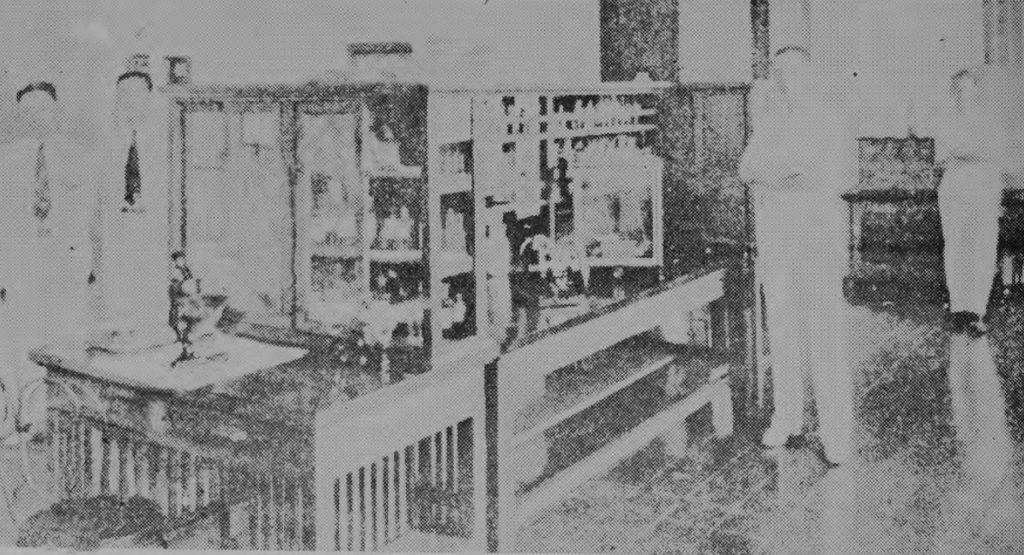
Curricular improvements were started in the 1970’s but noteworthy developmental changes marked the 80’s with the following:
- Establishment of Dr. Hubert Wong Learning Resources Unit on September 24, 1982;
- Establishment of Health Science Research Management Group in August 1984;
- Improved faculty development program through international linkages and recruitment of professorial and research chairs;
- Renovation of medical school rooms and facilities through legacies of jubilarian classes;
- Improved organizational structure with the creation of new departments notably the Department of Medical Education (1984) and Department of Bioethics (1992);
- Curricular innovations in the form of horizontal and vertical integration and the use of problem-oriented medical rounds;
- Publication of the Handbook of Medical and Surgical Emergencies and revival of the Santo Tomas Journal of Medicine; and
- Publication of the Handbook of Medical and Surgical Emergencies and revival of the Santo Tomas Journal of Medicine.
At the turn of the millennium, in 2001 a major curricular change was instituted, the Problem Based Learning (PBL) or Innovative Curriculum. The daring move to undergo a problem-based curriculum proved to have its inherent advantages and disadvantages as the Faculty struggled to smoothly implement the change. The physical environment underwent a major overhaul towards small group-based discussions. The Faculty was reoriented to the intricacies of PBL teaching including the organ-based design of classroom discussions. Students were likewise given a wider latitude on how they will imbibe, assimilate and apply their knowledge through creative activities intended to enhance the maturity required for self-directed learning. The learning environment became learner-directed rather than mentor-projected paving the way for a new era of educational strategies in the Faculty.
Two years later, the curriculum was reverted to the integrated approach but with adoption of some learning and evaluation strategies used in the PBL. Presently, the Faculty of Medicine and Surgery implements a “blended” integrated approach, adopting PBL as a teaching model in appropriate teaching-learning scenarios, utilizing its strong emphasis on self-directed and discovery learning to construct and build medical knowledge. It likewise employs direct teaching strategies whenever useful to emphasize the need for long term retention and lasting comprehension essential to medical education.
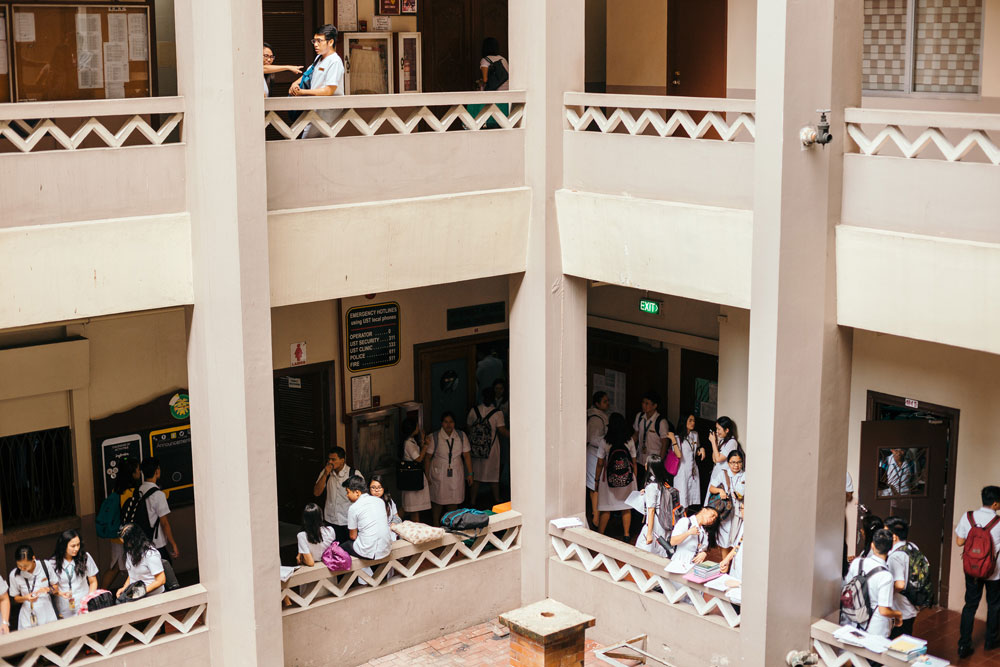
In 2010, the FMS began exploring the possibility of incorporating ultrasound medicine in its curriculum. Correspondences were established with key institutions providing ultrasound education in medicine and subsequent workshops and lectures were conducted by pioneering ultrasound educators in the US. A “core group” of medical educators in the areas of musculoskeletal medicine and orthopedics, rheumatology, pathology, radiology and internal medicine began the seminal trainings for the eventual integration.
In 2011, a series of ultrasound hands-on workshops were conducted both to academic staff and interested medical learners who expressed interest and inclination towards this innovative idea.
In 2012, the Department of Medical Education completed the integration of ultrasound in both the basic and clinical subjects, paving the way for the first of its kind in Philippine medical education.
In 2013, heeding the call to move towards “outcomes-based education”, the FMS improved its facilities by establishing a “Skills and Simulation Center for the Health Sciences (SSCHS)”. The four (4) storey laboratory housed the following facilities: Surgical Skills Facility (SSF), Life Support Science Laboratory, Ultrasound Laboratory, and the Clinical Skills Facility (CSF).
Beginning AY 2014-15, a fully integrated ultrasound syllabus was taught to Thomasian medical learners from first to fourth year.
In 2015, the Faculty of Medicine and Surgery formally implemented the OBE curriculum.
The Faculty of Medicine and Surgery has consistently dominated the Physician Licensure Examination and in the September 2016 examination, six (6) Thomasians grabbed places in the top ten. It marked the highest number of topnotchers in the history of FMS. Every year for several years now, we continue to take pride in our graduates. FMS has been consistently recognized as a top-performing school by the Professional Regulatory Commission.
In the same year, the FMS Life Support Training Center (LSTC) was conferred the Platinum Award for becoming the fourth largest AHA International training center in the world regarding the number of students trained.
In 2017, the Faculty of Medicine and Surgery welcomed the Journal of Medicine, University of Santo Tomas (JMUST), the reinvented scholarly publication of FMS is dedicated to provide healthcare practitioners with the best and most updated information in health science research and education.
The year 2018 marked a significant milestone for FMS. One of the highlights of the year was the successful resurvey by the Philippine Accrediting Association of Schools, Colleges, and Universities (PAASCU) for level 3 accreditation. This achievement underscored the FMS’ commitment to maintaining high academic standards and providing a quality education to its students.
In the same year, FMS also boasted of the pioneer class of the Learning Enhanced Accelerated Program for Medicine (LEAPMed). This comprehensive medical education program was considered a model template for all accelerated learning programs for medicine in the country. The Masters in Public Health International program was also established in partnership with the Nuffield Centre for International Health and Development at the University of Leeds, United Kingdom. It aims to equip graduates with the skills and knowledge necessary to address global health challenges. Furthermore, the Organ Donation Innovative Strategies for Southeast Asia (ODISSeA) project, a specialized post-graduate certificate program in organ donation, tapped FMS as one of only eight Southeast Asian beneficiary universities to offer a training program for transplant specialists designed by the University of Barcelona.
And last but definitely not the least, in fact a notable achievement was the establishment of the Anargyroi: FMS Foundation, Inc. (AFI). The AFI is an independent organization that manages donations and exclusively supports FMS towards the realization of its goals, sustains and aids initiatives influencing administration, faculty, students, support staff, and patients. This was conceptualized as an altruistic expression of gratitude by the medical alumni. They are benevolent with their endowments and magnanimous in their donations towards the pioneering educational initiatives of the FMS, which will not only GIVE but will also BRIDGE to others of similar goodwill.

In 2019, a group of educators from the Faculty of Medicine and Surgery attended the World Federation of Medical Education in Seoul, South Korea. During the convention, the delegation presented 12 of their research works, showcasing FMS’ commitment to sharing knowledge and experience in medical education.
The COVID-19 pandemic presented unprecedented challenges to medical education worldwide. However, FMS was able to adapt quickly and effectively to the new circumstances. In 2020, FMS successfully transitioned to online learning using the UST-Learning Management System, ensuring that students continued to receive a high-quality education despite the disruptions caused by the pandemic. In addition to online learning, the faculty also devised innovative ways to conduct traditional Oral Revalida. This ensured that students were able to demonstrate their clinical knowledge and skills in a safe and effective manner.
In 2021, one of the most notable achievements was the award of the QS 5-STAR rank for Medicine (Program Strength) given by the QS World University rankings. In addition to this, the Senate and Congress officially commended FMS as the premier medical school in the Philippines, acknowledging its outstanding contributions for the past 150 years.
In terms of infrastructure, the rear portion of the Medicine building underwent a significant renovation, providing students and faculty with improved facilities and learning spaces.
The year 2021 also marked the reopening of onsite classes, allowing students, teachers, and academic personnel to return to the physical campus. To ensure the safety of the community, vaccination programs were implemented, making FMS one of the first medical schools to vaccinate its members against COVID-19. In recognition of its commitment to safety protocols, FMS was awarded the CHED Safety Seal.
Finally, towards the end of 2021, the long-awaited Sesquicentennial celebration was held. The sesquicentennial marker was installed at the original site of FMS in Plaza Santo Tomas Intramuros, Manila, commemorating FMS’ 150 years of existence and excellence.
The year 2022 was marked by the commencement of the construction of the Henry Sy Sr. Hall, which would house the Faculty of Medicine and Surgery Saints Cosmas and Damian Center for Simulation and Research. Another significant milestone is launching a commemorative book entitled “Honora Medicum”, which pays tribute to the 150 years of service to the nation of over 40,000 graduates from the Philippines’ oldest medical school. The following year, April 2023, this book bagged a gold and silver Award of Merit in the prestigious International Association of Business Communicators (IABC) Quill Awards 2023.
In the same year, two of the esteemed educators of FMS were conferred the Doña Victoria Ty Tan Professorial Chair, namely, Prof. Angeles Tan Alora, M.D and Prof. María Minerva P. Calimag, M.D., PhD, both exemplified the ideals of a 5-star physician and Thomasian professional.
Journal of Medicine, University of Santo Tomas (JMUST), has published 12 issues since its reinvention with more than 160 articles to date. JMUST is indexed in HERDIN Plus, WPRIM, CrossRef, Google Scholar, Semantic Scholar, Scilit, ResearchGate, OpenAire, and Academia. It has gained 50 citations from all articles, some from highly reputed journals.
This year, FMS continues to soar high and lead the era of medical education as it inaugurates the Henry Sy Sr. Hall. This state-of-the-art facility represents a major investment in medical education, providing students with a cutting-edge learning environment that closely replicates real-world clinical scenarios. This new facility will undoubtedly have a lasting impact on the future of healthcare in the Philippines.

Sesquicentennial plans include:
1. A comprehensive review of the history of the Faculty and its early graduates including Dr. Jose Rizal and other national figures, hoping to fill out missing segments and discover new highlights in our saga as a medical school.
2. Reach out to our alumni (Thomasians comprise close to 50% of the physicians graduating from Philippine medical schools between 20,000-25,000 presently alive).
3. Accomplish at least 150 medico-surgical missions from September 2016 to May 2021.
4. Set up an alumni fund for thomasian medical students to augment existing scholarship funds of the Faculty.
5. Initiate 150 research projects from basic and clinical medical sciences for partial/final submission by May 2021. Revival of the Santo Tomas Journal of Medicine as a recognized medium to publish our research.
6. Establish global linkages with other Catholic medical schools in line with the University’s drive for internationalization.
7. Upgrade of physical facililties.


